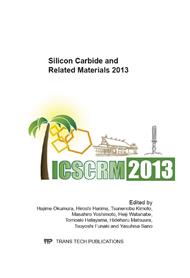p.549
p.553
p.557
p.562
p.566
p.571
p.575
p.579
p.583
Nano-Scale Native Oxide on 6H-SiC Surface and its Effect on the Ni/Native Oxide/SiC Interface Band Bending
Abstract:
Native oxide layer with thickness of about 1 nm was found easy to form on 6H-SiC surface during transporting from cleaning process to vacuum chambers, which was examined by x-ray photoelectron spectroscopy (XPS) and high-resolution transmission electron microscopy (HRTEM). The interface band bending was studied by synchrotron radiation photoelectron spectroscopy (SRPES). For the native-oxide/SiC surface, after Ni deposition, the binding energy of Si 2p red-shifted about 0.34 eV, which suggested the upward bending of the interface energy band. Therefore, the native oxide layer should be considered on the study of SiC devices because it may affect the electron transport properties significantly.
Info:
Periodical:
Pages:
566-570
Citation:
Online since:
February 2014
Authors:
Price:
Сopyright:
© 2014 Trans Tech Publications Ltd. All Rights Reserved
Share:
Citation:


